Ubiquiti UniFi AP AC In-Wall User manual
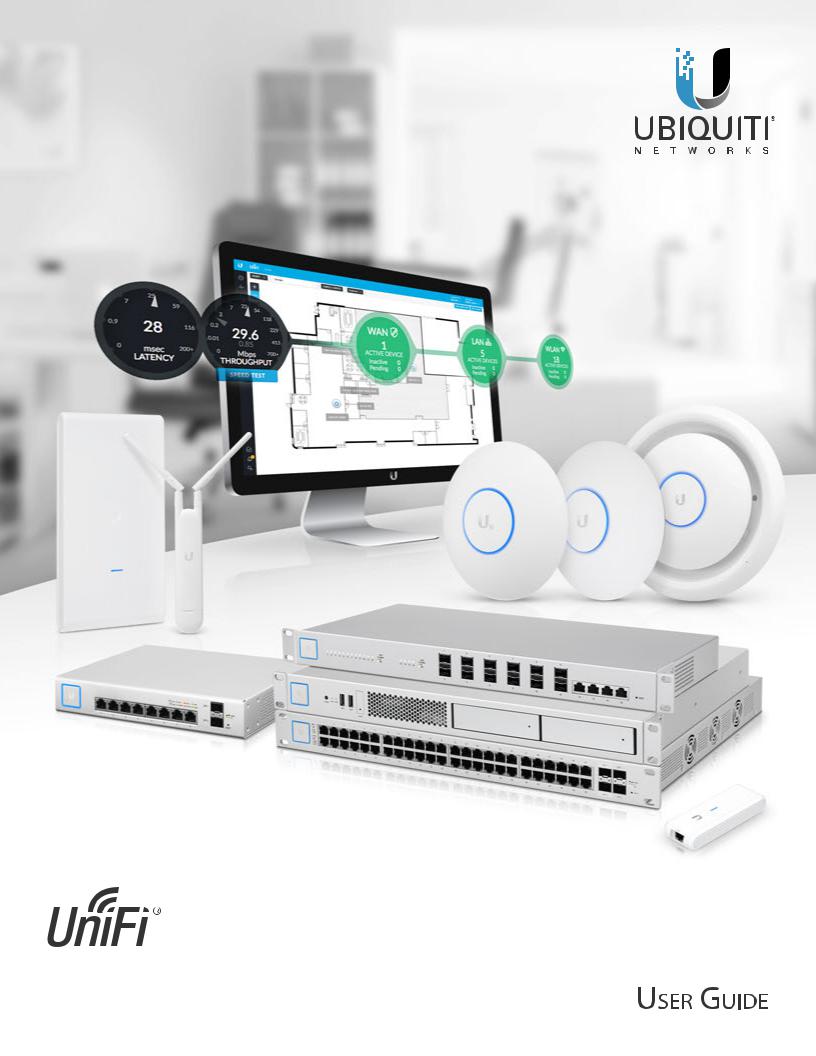
Enterprise System Controller
Release Version: 5.6.2

UniFi Controller User Guide |
Table of Contents |
Table of Contents |
|
Chapter 1: Software Installation. . . . . . . . . . . . . . . . . . . . . . . . . . . . . . . . . . . . |
. 1 |
Introduction.. .. .. .. .. .. .. .. .. .. .. .. .. .. .. .. .. .. .. .. .. .. .. .. .. .. .. .. .. .. .. .. .. .. .. .. .. .. .. .. .. .. .. .. .. .. .. .. .. .. .. .. .. .. .. .. .. .. .. .. .. .. .. .. .. .. .. .. .. .. 1 |
|
System Requirements .. . . . . . . . . . . . . . . . . . . . . . . . . . . . . . . . . . . . . . . . . . . . . . . . . . . . . . . . . . |
. . 1 |
Network Topology Requirements.. . . . . . . . . . . . . . . . . . . . . . . . . . . . . . . . . . . . . . . . . . . . . . . |
. . 1 |
Software Installation. . . . . . . . . . . . . . . . . . . . . . . . . . . . . . . . . . . . . . . . . . . . . . . . . . . . . . . . . . . . . |
. 1 |
Chapter 2: UniFi Cloud. . . . . . . . . . . . . . . . . . . . . . . . . . . . . . . . . . . . . . . . . . . . . |
. 5 |
Introduction.. .. .. .. .. .. .. .. .. .. .. .. .. .. .. .. .. .. .. .. .. .. .. .. .. .. .. .. .. .. .. .. .. .. .. .. .. .. .. .. .. .. .. .. .. .. .. .. .. .. .. .. .. .. .. .. .. .. .. .. .. .. .. .. .. .. .. .. .. .. 5 |
|
UniFi Cloud Key .. . . . . . . . . . . . . . . . . . . . . . . . . . . . . . . . . . . . . . . . . . . . . . . . . . . . . . . . . . . . . . . . |
. . 5 |
UniFi Cloud Account. . . . . . . . . . . . . . . . . . . . . . . . . . . . . . . . . . . . . . . . . . . . . . . . . . . . . . . . . . . . |
. 13 |
Chapter 3: Using the UniFi Controller Software.. . . . . . . . . . . . . . . . . . . . |
. 17 |
Navigation Bar .. . . . . . . . . . . . . . . . . . . . . . . . . . . . . . . . . . . . . . . . . . . . . . . . . . . . . . . . . . . . . . . . . |
.17 |
Common Interface Options.. . . . . . . . . . . . . . . . . . . . . . . . . . . . . . . . . . . . . . . . . . . . . . . . . . . . . |
. 17 |
Chapter 4: Dashboard.. . . . . . . . . . . . . . . . . . . . . . . . . . . . . . . . . . . . . . . . . . . . |
. 63 |
Latency.. . . . . . . . . . . . . . . . . . . . . . . . . . . . . . . . . . . . . . . . . . . . . . . . . . . . . . . . . . . . . . . . . . . . . . . . |
.63 |
Throughput.. . . . . . . . . . . . . . . . . . . . . . . . . . . . . . . . . . . . . . . . . . . . . . . . . . . . . . . . . . . . . . . . . . . . |
.63 |
WAN.. . . . . . . . . . . . . . . . . . . . . . . . . . . . . . . . . . . . . . . . . . . . . . . . . . . . . . . . . . . . . . . . . . . . . . . . . . . |
.64 |
LAN.. . . . . . . . . . . . . . . . . . . . . . . . . . . . . . . . . . . . . . . . . . . . . . . . . . . . . . . . . . . . . . . . . . . . . . . . . . . . |
.64 |
WLAN.. . . . . . . . . . . . . . . . . . . . . . . . . . . . . . . . . . . . . . . . . . . . . . . . . . . . . . . . . . . . . . . . . . . . . . . . . . |
.65 |
Download Throughput & Latency. . . . . . . . . . . . . . . . . . . . . . . . . . . . . . . . . . . . . . . . . . . . . . . |
. 65 |
Upload Throughput & Latency. . . . . . . . . . . . . . . . . . . . . . . . . . . . . . . . . . . . . . . . . . . . . . . . . . |
. 65 |
Devices on 2..4 GHz Radio Band.. . . . . . . . . . . . . . . . . . . . . . . . . . . . . . . . . . . . . . . . . . . . . . . . . |
.66 |
Devices on 5 GHz Radio Band.. . . . . . . . . . . . . . . . . . . . . . . . . . . . . . . . . . . . . . . . . . . . . . . . . . . |
. 66 |
Clients on 2..4 GHz Radio Band.. . . . . . . . . . . . . . . . . . . . . . . . . . . . . . . . . . . . . . . . . . . . . . . . . . |
.67 |
Clients on 5 GHz Radio Band.. . . . . . . . . . . . . . . . . . . . . . . . . . . . . . . . . . . . . . . . . . . . . . . . . . . . |
. 67 |
Devices .. . . . . . . . . . . . . . . . . . . . . . . . . . . . . . . . . . . . . . . . . . . . . . . . . . . . . . . . . . . . . . . . . . . . . . . . |
.68 |
Clients .. . . . . . . . . . . . . . . . . . . . . . . . . . . . . . . . . . . . . . . . . . . . . . . . . . . . . . . . . . . . . . . . . . . . . . . . . |
.68 |
Deep Packet Inspection......................................................... |
. 68 |
Dynamic Dashboard (beta).. . . . . . . . . . . . . . . . . . . . . . . . . . . . . . . . . . . . . . . . . . . . . . . . . . . . . |
.69 |
Chapter 5: Statistics .. . . . . . . . . . . . . . . . . . . . . . . . . . . . . . . . . . . . . . . . . . . . . . |
. 71 |
Overview....................................................................... |
. 71 |
Traffic Stats. . . . . . . . . . . . . . . . . . . . . . . . . . . . . . . . . . . . . . . . . . . . . . . . . . . . . . . . . . . . . . . . . . . . . |
. 73 |
Performance .. . . . . . . . . . . . . . . . . . . . . . . . . . . . . . . . . . . . . . . . . . . . . . . . . . . . . . . . . . . . . . . . . . . |
.76 |
Switch Stats.. . . . . . . . . . . . . . . . . . . . . . . . . . . . . . . . . . . . . . . . . . . . . . . . . . . . . . . . . . . . . . . . . . . . |
.77 |
Speed Test Stats.. . . . . . . . . . . . . . . . . . . . . . . . . . . . . . . . . . . . . . . . . . . . . . . . . . . . . . . . . . . . . . . . |
. 78 |
Debugging Metrics. . . . . . . . . . . . . . . . . . . . . . . . . . . . . . . . . . . . . . . . . . . . . . . . . . . . . . . . . . . . . |
. 78 |
Ubiquiti Networks, Inc. |
i |
Table of Contents |
UniFi Controller User Guide |
Chapter 6: Map. . . . . . . . . . . . . . . . . . . . . . . . . . . . . . . . . . . . . . . . . . . . . . . . . . . |
. 81 |
Adding Custom Maps.. .. .. .. .. .. .. .. .. .. .. .. .. .. .. .. .. .. .. .. .. .. .. .. .. .. .. .. .. .. .. .. .. .. .. .. .. .. .. .. .. .. .. .. .. .. .. .. .. .. .. .. .. .. .. .. .. .. .. ..81 |
|
Adding a Google Map.. . . . . . . . . . . . . . . . . . . . . . . . . . . . . . . . . . . . . . . . . . . . . . . . . . . |
. . . . . . . .82 |
Editing a Map .. . . . . . . . . . . . . . . . . . . . . . . . . . . . . . . . . . . . . . . . . . . . . . . . . . . . . . . . . . . |
. . . . . . . .83 |
Placing Devices on the Map..................................................... |
. 84 |
Device Information.. . . . . . . . . . . . . . . . . . . . . . . . . . . . . . . . . . . . . . . . . . . . . . . . . . . . . . . . . . . . |
. .84 |
Map Display Options.. . . . . . . . . . . . . . . . . . . . . . . . . . . . . . . . . . . . . . . . . . . . . . . . . . . . |
. . . . . . . .85 |
Drawing Walls.. . . . . . . . . . . . . . . . . . . . . . . . . . . . . . . . . . . . . . . . . . . . . . . . . . . . . . . . . . . . . . . . . . |
.87 |
Setting the Map Scale .. . . . . . . . . . . . . . . . . . . . . . . . . . . . . . . . . . . . . . . . . . . . . . . . . . . |
. . . . . . . .87 |
System Topology.. . . . . . . . . . . . . . . . . . . . . . . . . . . . . . . . . . . . . . . . . . . . . . . . . . . . . . . . . . . . . |
. . .88 |
Chapter 7: Devices .. . . . . . . . . . . . . . . . . . . . . . . . . . . . . . . . . . . . . . . . . . |
. . . . . . 89 |
All.............................................................................. |
. 91 |
Gateway/Switches. . . . . . . . . . . . . . . . . . . . . . . . . . . . . . . . . . . . . . . . . . . . . . . . . . . . . . . . . . . . . . |
. 92 |
APs .. . . . . . . . . . . . . . . . . . . . . . . . . . . . . . . . . . . . . . . . . . . . . . . . . . . . . . . . . . . . . . . . . . . . . |
. . . . . . . .95 |
Chapter 8: Clients .. . . . . . . . . . . . . . . . . . . . . . . . . . . . . . . . . . . . . . . . . . . |
. . . . . . 99 |
All............................................................................. |
102 |
Wireless.. . . . . . . . . . . . . . . . . . . . . . . . . . . . . . . . . . . . . . . . . . . . . . . . . . . . . . . . . . . . . . . . . . . . . . . |
103 |
Wired.. . . . . . . . . . . . . . . . . . . . . . . . . . . . . . . . . . . . . . . . . . . . . . . . . . . . . . . . . . . . . . . . . . . |
. . . . . . 104 |
Chapter 9: Insights .. . . . . . . . . . . . . . . . . . . . . . . . . . . . . . . . . . . . . . . . . . |
. . . . . 105 |
Neighboring Access Points .. . . . . . . . . . . . . . . . . . . . . . . . . . . . . . . . . . . . . . . . . . . . . . |
. . . . . . 106 |
Known Clients. . . . . . . . . . . . . . . . . . . . . . . . . . . . . . . . . . . . . . . . . . . . . . . . . . . . . . . . . . . . . . . . . |
106 |
Past Connections.. . . . . . . . . . . . . . . . . . . . . . . . . . . . . . . . . . . . . . . . . . . . . . . . . . . . . . . . . . . . . . |
107 |
Past Guest Authorizations .. . . . . . . . . . . . . . . . . . . . . . . . . . . . . . . . . . . . . . . . . . . . . . . |
. . . . . . 108 |
Switch Stats.. . . . . . . . . . . . . . . . . . . . . . . . . . . . . . . . . . . . . . . . . . . . . . . . . . . . . . . . . . . . . |
. . . . . . 108 |
Port Forward Stats. . . . . . . . . . . . . . . . . . . . . . . . . . . . . . . . . . . . . . . . . . . . . . . . . . . . . . . . . . . . . |
111 |
Dynamic DNS .. . . . . . . . . . . . . . . . . . . . . . . . . . . . . . . . . . . . . . . . . . . . . . . . . . . . . . . . . . . |
. . . . . . 113 |
Remote User VPN. . . . . . . . . . . . . . . . . . . . . . . . . . . . . . . . . . . . . . . . . . . . . . . . . . . . . . . . . . . . . . |
113 |
AC-EDU Streams. . . . . . . . . . . . . . . . . . . . . . . . . . . . . . . . . . . . . . . . . . . . . . . . . . . . . . . . . . . . . . . |
114 |
Controller Logs.. . . . . . . . . . . . . . . . . . . . . . . . . . . . . . . . . . . . . . . . . . . . . . . . . . . . . . . . . . . . . . . . |
114 |
Chapter 10: UniFi Security Gateway Details .. . . . . . . . . . . . . . . . . . . . . . . 115
Properties.. . . . . . . . . . . . . . . . . . . . . . . . . . . . . . . . . . . . . . . . . . . . . . . . . . . . . . . . . . . . . . . . . . . . . 115
UniFi Security Gateway – Details.. . . . . . . . . . . . . . . . . . . . . . . . . . . . . . . . . . . . . . . . . . . . . . . 116
UniFi Security Gateway – Networks .. . . . . . . . . . . . . . . . . . . . . . . . . . . . . . . . . . . . . . . . . . . . 117
UniFi Security Gateway – Configuration.. . . . . . . . . . . . . . . . . . . . . . . . . . . . . . . . . . . . . . . . 117
Chapter 11: UniFi Switch Details.. . . . . . . . . . . . . . . . . . . . . . . . . . . . . . . . |
. . 121 |
Properties.. . . . . . . . . . . . . . . . . . . . . . . . . . . . . . . . . . . . . . . . . . . . . . . . . . . . . . . . . . . . . . . . . . . . . |
121 |
UniFi Switch – Details. . . . . . . . . . . . . . . . . . . . . . . . . . . . . . . . . . . . . . . . . . . . . . . . . . . . . . . . . . |
122 |
UniFi Switch – Users.. . . . . . . . . . . . . . . . . . . . . . . . . . . . . . . . . . . . . . . . . . . . . . . . . . . . . . . . . |
. . 123 |
UniFi Switch – Guests.. . . . . . . . . . . . . . . . . . . . . . . . . . . . . . . . . . . . . . . . . . . . . . . . . . . . . . . . . . |
123 |
UniFi Switch – Ports .. . . . . . . . . . . . . . . . . . . . . . . . . . . . . . . . . . . . . . . . . . . . . . . . . . . . . . . . . . |
. 124 |
UniFi Switch – Configuration. . . . . . . . . . . . . . . . . . . . . . . . . . . . . . . . . . . . . . . . . . . . . . . . . . . |
127 |
ii |
Ubiquiti Networks, Inc. |
UniFi Controller User Guide |
Table of Contents |
Chapter 12: UniFi Access Point Details .. . . . . . . . . . . . . . . . . . . . . . . . . . . . |
131 |
Properties.. . . . . . . . . . . . . . . . . . . . . . . . . . . . . . . . . . . . . . . . . . . . . . . . . . . . . . . . . . . . . . . . . . . . . |
131 |
UniFi Access Point – Details.. . . . . . . . . . . . . . . . . . . . . . . . . . . . . . . . . . . . . . . . . . . . . . . . . . . . |
132 |
UniFi Access Point – Guests.. . . . . . . . . . . . . . . . . . . . . . . . . . . . . . . . . . . . . . . . . . . . . . . . . . . . |
134 |
UniFi Access Point – Configuration.. . . . . . . . . . . . . . . . . . . . . . . . . . . . . . . . . . . . . . . . . . . . . |
135 |
UniFi Access Point – Tools. . . . . . . . . . . . . . . . . . . . . . . . . . . . . . . . . . . . . . . . . . . . . . . . . . . . . . |
141 |
Chapter 13: Client Details......................................... |
147 |
Properties.. . . . . . . . . . . . . . . . . . . . . . . . . . . . . . . . . . . . . . . . . . . . . . . . . . . . . . . . . . . . . . . . . . . . . |
147 |
Wireless Client – Details .. . . . . . . . . . . . . . . . . . . . . . . . . . . . . . . . . . . . . . . . . . . . . . . . . . . . . . . |
147 |
Wireless Client – History.. . . . . . . . . . . . . . . . . . . . . . . . . . . . . . . . . . . . . . . . . . . . . . . . . . . . . . . |
148 |
Wireless Client – Configuration .. . . . . . . . . . . . . . . . . . . . . . . . . . . . . . . . . . . . . . . . . . . . . . . . |
148 |
Wired Client – Details. . . . . . . . . . . . . . . . . . . . . . . . . . . . . . . . . . . . . . . . . . . . . . . . . . . . . . . . . . |
149 |
Wired Client – Statistics. . . . . . . . . . . . . . . . . . . . . . . . . . . . . . . . . . . . . . . . . . . . . . . . . . . . . . . . |
149 |
Wired Client – History .. . . . . . . . . . . . . . . . . . . . . . . . . . . . . . . . . . . . . . . . . . . . . . . . . . . . . . . . . |
150 |
Wired Client – Configuration. . . . . . . . . . . . . . . . . . . . . . . . . . . . . . . . . . . . . . . . . . . . . . . . . . . |
150 |
Chapter 14: Hotspot Manager.. . . . . . . . . . . . . . . . . . . . . . . . . . . . . . . . . . . . |
151 |
Analytics.. . . . . . . . . . . . . . . . . . . . . . . . . . . . . . . . . . . . . . . . . . . . . . . . . . . . . . . . . . . . . . . . . . . . . . |
152 |
Guests .. . . . . . . . . . . . . . . . . . . . . . . . . . . . . . . . . . . . . . . . . . . . . . . . . . . . . . . . . . . . . . . . . . . . . . . . |
152 |
Payments and Transactions.. . . . . . . . . . . . . . . . . . . . . . . . . . . . . . . . . . . . . . . . . . . . . . . . . . . . |
153 |
Vouchers.. . . . . . . . . . . . . . . . . . . . . . . . . . . . . . . . . . . . . . . . . . . . . . . . . . . . . . . . . . . . . . . . . . . . . . |
154 |
Operator Accounts.. . . . . . . . . . . . . . . . . . . . . . . . . . . . . . . . . . . . . . . . . . . . . . . . . . . . . . . . . . . . |
155 |
Appendix A: Portal Customization with Legacy JSP................ |
157 |
Before You Begin.. . . . . . . . . . . . . . . . . . . . . . . . . . . . . . . . . . . . . . . . . . . . . . . . . . . . . . . . . . . . . . |
157 |
Overview...................................................................... |
157 |
Configuring Portal Customization. . . . . . . . . . . . . . . . . . . . . . . . . . . . . . . . . . . . . . . . . . . . . . |
157 |
Viewing the Default Portal.. . . . . . . . . . . . . . . . . . . . . . . . . . . . . . . . . . . . . . . . . . . . . . . . . . . . . |
158 |
Setup.. . . . . . . . . . . . . . . . . . . . . . . . . . . . . . . . . . . . . . . . . . . . . . . . . . . . . . . . . . . . . . . . . . . . . . . . . |
158 |
Appendix B: UniFi Mobile App. . . . . . . . . . . . . . . . . . . . . . . . . . . . . . . . . . . . |
161 |
Overview...................................................................... |
161 |
Standalone Mode .. . . . . . . . . . . . . . . . . . . . . . . . . . . . . . . . . . . . . . . . . . . . . . . . . . . . . . . . . . . . . |
161 |
Controller Mode. . . . . . . . . . . . . . . . . . . . . . . . . . . . . . . . . . . . . . . . . . . . . . . . . . . . . . . . . . . . . . . |
164 |
Appendix C: Controller Scenarios.. . . . . . . . . . . . . . . . . . . . . . . . . . . . . . . . . |
165 |
Overview...................................................................... |
165 |
Hosting Controller Software.. . . . . . . . . . . . . . . . . . . . . . . . . . . . . . . . . . . . . . . . . . . . . . . . . . . |
165 |
Deployment Options.. . . . . . . . . . . . . . . . . . . . . . . . . . . . . . . . . . . . . . . . . . . . . . . . . . . . . . . . . . |
165 |
Layer-3 Adoption. . . . . . . . . . . . . . . . . . . . . . . . . . . . . . . . . . . . . . . . . . . . . . . . . . . . . . . . . . . . . . |
168 |
Appendix D: Contact Information................................. |
171 |
Ubiquiti Networks Support.. . . . . . . . . . . . . . . . . . . . . . . . . . . . . . . . . . . . . . . . . . . . . . . . . . . . |
171 |
Ubiquiti Networks, Inc. |
iii |
Table of Contents |
UniFi Controller User Guide |
iv |
Ubiquiti Networks, Inc. |
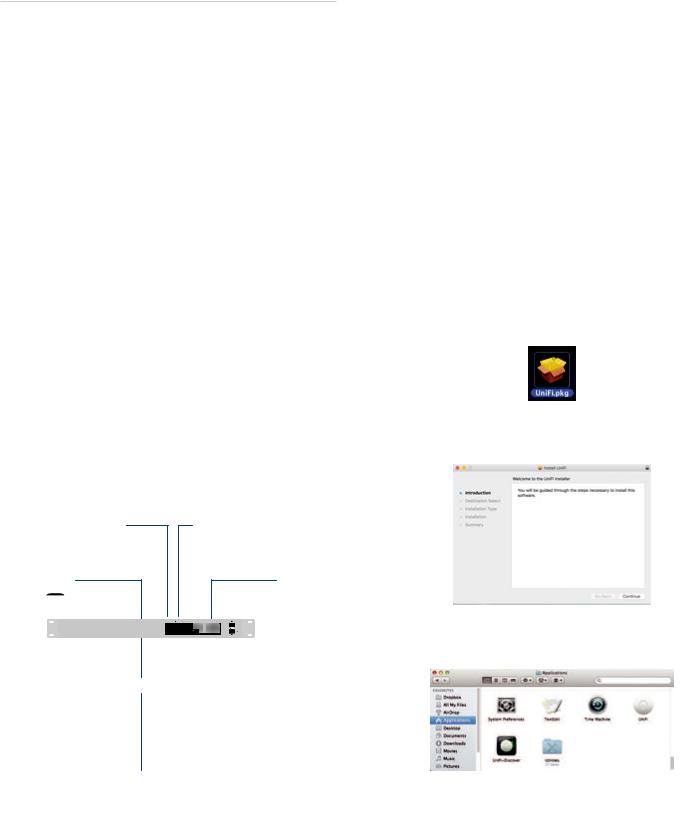
UniFi Controller User Guide
Chapter 1: Software
Installation
Introduction
Thank you for purchasing the Ubiquiti Networks® UniFi® Enterprise System.. The UniFi devices are bundled with the UniFi Controller software, which allows you to manage your UniFi network using a web browser..
This User Guide is for use with version 5..6..2 or above of the UniFi Controller software..
System Requirements
•Linux, Mac OS X 10.11 (or above), or Microsoft Windows 7/8/10
•Java Runtime Environment 1.8 or above recommended
•Web Browser: Google Chrome (Other browsers may have limited functionality..)
Network Topology Requirements
•A DHCP-enabled network (so any device can obtain an IP address)
•One of the following:
•UniFi Cloud Key
•A management station running the UniFi Controller software, located either on-site and connected to the same Layer-2 network, or off-site* in a cloud or NOC
•For the public address system capability of the UAP AC EDU: A compatible Android™ or iOS device located on the same Layer-2 network as the UniFi Controller and UniFi APs
UniFi Hybrid
Cloud Install
UAP-AC-HD UAP-AC-PRO
UAP-AC-M-PRO
US-16-150W
|
LAN |
USG-PRO-4 |
WAN |
(DHCP Server) |
|
Internet
Remote Access to
UniFi Controller
Sample Network Diagram
* Requires Layer-3 adoption.. For details, refer to: http://ubnt.link/UniFi-Layer3-Adoption
Chapter 1: Software Installation
All UniFi devices support off-site management controllers..
Follow the instructions in this chapter after you install the hardware, which is described in the Quick Start Guide..
Software Installation
Download the latest version of the UniFi Controller software at downloads.ubnt.com/unifi
Follow the instructions for your specific computer or device type..
UniFi Cloud Key Users
If you have the UniFi Cloud Key, please refer to “UniFi Cloud Key” on page 5 for more information..
UniFi Cloud Users
If you have a UniFi cloud account, please refer to “UniFi Cloud Account” on page 13 for more information..
Linux Users
Please refer to the UniFi blog on our community site at: http://ubnt.link/UniFi-Blog
Mac Users
1.Launch UniFi.pkg..
2.Click Continue and follow the on-screen instructions to install the software..
3.Go to Go > Applications and double-click the UniFi icon..
Proceed to “Configuring the UniFi Controller Software” on page 2..
Ubiquiti Networks, Inc. |
1 |
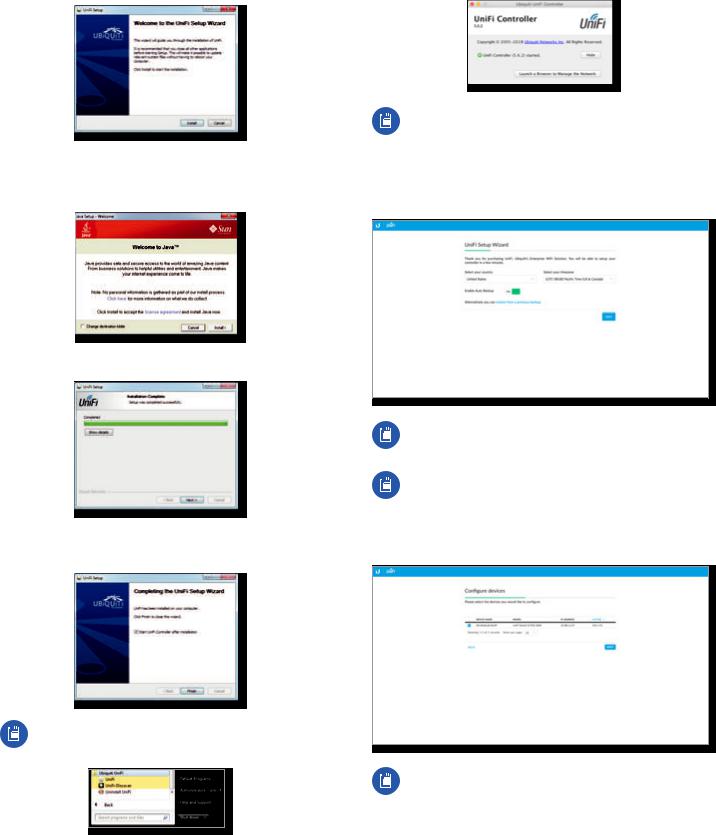
Chapter 1: Software Installation
PC Users
1.Launch UniFi-installer.exe..
2.Click Install..
3.If your computer doesn’t have Java 1.6 or above installed, you will be prompted to install it.. Click Install to continue..
4. Click Next..
5.Ensure that the Start UniFi Controller after installation option is checked and click Finish..
Note: The UniFi Controller software can also be launched from Start > All Programs..
UniFi Controller User Guide
Configuring the UniFi Controller Software
1.The UniFi Controller software startup will begin.. Click
Launch a Browser to Manage Wireless Network..
Note: The above applies to Windows and OS X only.
On Linux, open a browser and go to the following URL: https://<IP_address_of_controller>:8443
2.Select your country and time zone.. Alternatively, you can click restore from a previous backup to use a file that contains your backup settings.. Click Next..
Note: Enable Auto Backup is on by default.. Toggle off if you wish to disable..
Note: U..S.. product versions are locked to the U..S.. Country Code to ensure compliance with FCC regulations..
3.Select the devices that you want to configure and click Next..
Note: If there is more than one page of entries to display, click the navigation controls or page
numbers at the bottom right of the screen to display different pages..
2 |
Ubiquiti Networks, Inc. |
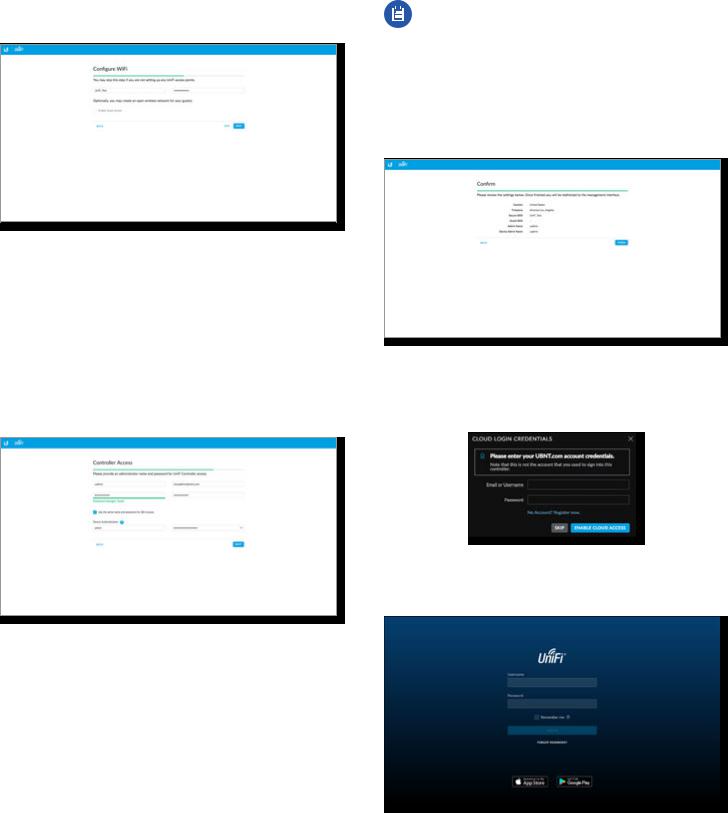
UniFi Controller User Guide
4.The UniFi Setup Wizard will create a secure primary wireless network for your devices..
Perform the following steps:
a.Enter the wireless network name (SSID) in the Secure SSID field..
b.Enter a passphrase to be used for your primary network in the Security Key field..
c.To enable guest access, select Enable Guest Access, and enter a guest network name in the Guest
SSIDfield..
d.Click Next..
5.Create the superadmin for your UniFi Controller..
Perform the following steps:
a.Enter an admin name in the Admin Name field..
b.Enter an email address in the Admin Email field..
c.Enter a password in the Password field to use when accessing the management interface as a superadmin..
d.Confirm your password in the Confirm Password field..
e.To use the same login for SSH access, select Use the same name and password for SSH access..
f.To set up a separate login for SSH access, enter an admin name and password for the Device Authentication fields..
g.Click Next..
Chapter 1: Software Installation
Note: Only the superadmin and admins who have permission to adopt devices can view devices that are Pending Approval and then adopt them on the UniFi Controller.. Ensure that you save the superadmin login information for future use.
6.Review your settings.. Click Finish to save your settings or click Back to make changes.. Once the wizard is finished, the browser will be redirected to the Cloud Login Credentials screen..
7.Enter your Ubiquiti account email/username and password to enable cloud access.. Alternatively, you can click Register now to create a Ubiquiti account.. Click
Enable Cloud Access..
8.A login screen will appear for the UniFi Controller management interface.. Enter the admin name and password that you created and click Sign In..
Proceed to “Using the UniFi Controller Software” on page 17 for information on using the UniFi Controller software..
Ubiquiti Networks, Inc. |
3 |
Chapter 1: Software Installation |
UniFi Controller User Guide |
4 |
Ubiquiti Networks, Inc. |
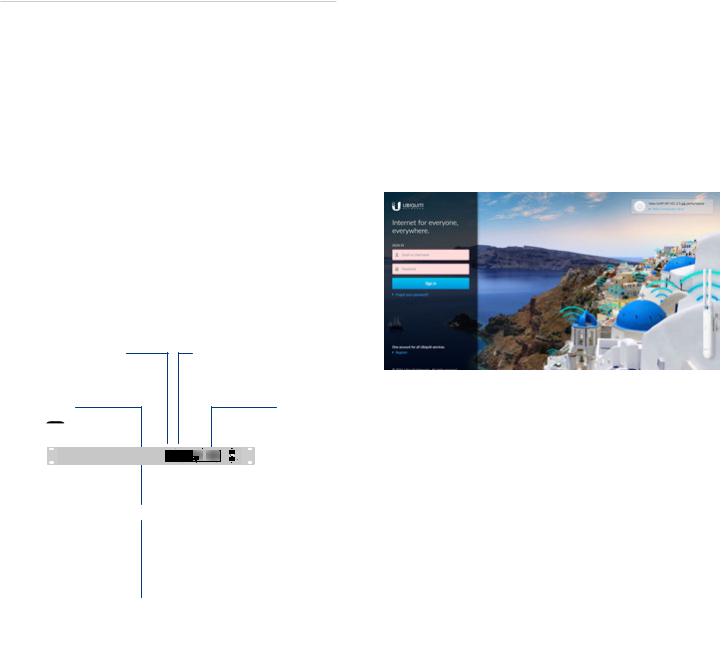
UniFi Controller User Guide
Chapter 2: UniFi Cloud
Introduction
You can access the UniFi Controller via the UniFi Cloud Key and/or the UniFi cloud account.. This chapter describes the following:
•UniFi Cloud Key
•“UniFi Cloud Account” on page 13
UniFi Cloud Key
The UniFi Cloud Key includes the pre-installed UniFi Controller software..
System Requirement
Web Browser: Google Chrome (Other browsers may have limited functionality..)
Network Topology Requirement
A DHCP-enabled network (for the UniFi Cloud Key to obtain an IP address)
UniFi Hybrid
Cloud Install
UAP-AC-HD UAP-AC-PRO
UAP-AC-M-PRO
US-16-150W
|
LAN |
USG-PRO-4 |
WAN |
(DHCP Server) |
|
Internet
Remote Access to
UniFi Controller
Sample Network Diagram
Software Installation
After you follow the hardware installation instructions in the UniFi Cloud Key Quick Start Guide, use one of the following methods to launch the software:
•If you are using Chrome, go to the Chrome Instructions section (recommended)..
•If you are using a different web browser, go to
“Instructions for Other Web Browsers” on page 7..
Chapter 2: UniFi Cloud
Chrome Instructions
1.Ensure that your host system is on the same Layer-2 network as the UniFi Cloud Key.
2.Launch the Chrome web browser and type https://unifi.ubnt.com in the address field.. Press enter
(PC) or return (Mac)..
https://unifi.ubnt.com
3.Enter the username and password for your UBNT account.. Click Sign In..
4. Click Discover Cloud Key..
Note: The default fallback IP address of the UniFi Cloud Key is 192.168.1.30..
5.If the Ubiquiti® Device Discovery Tool is already installed, proceed to step 7..
If the tool is not installed, you will be prompted to add it.. Proceed to step 6..
Ubiquiti Networks, Inc. |
5 |
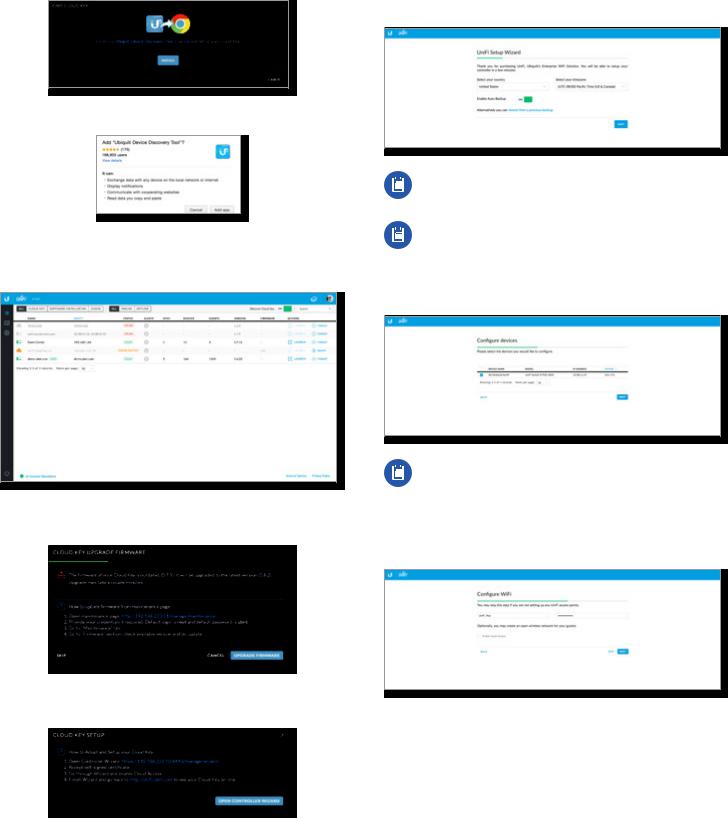
Chapter 2: UniFi Cloud
6.To install the tool: a. Click Install..
b. Click Add app to confirm..
7.The Ubiquiti Device Discovery Tool will search for the UniFi Cloud Key.. Click Adopt in the Cloud Key’s Actions column to continue..
8.If the Cloud Key firmware is not the latest version, click Upgrade Firmware to upgrade the firmware..
9.Click Open Controller Wizard to set up the Controller on the Cloud Key..
UniFi Controller User Guide
10.The UniFi Setup Wizard screen appears.. Select your country and time zone.. Alternatively, you can click restore from a previous backup to use a file that contains your backup settings.. Click Next..
Note: Enable Auto Backup is on by default.. Toggle off if you wish to disable..
Note: U..S.. product versions are locked to the U..S.. Country Code to ensure compliance with FCC regulations..
11.Select the devices that you want to configure and click Next..
Note: If there is more than one page of entries to display, click the navigation controls or page
numbers at the bottom right of the screen to display different pages..
12.The UniFi Setup Wizard will create a secure primary wireless network for your devices..
Perform the following steps:
a.Enter the wireless network name (SSID) in the Secure SSID field..
b.Enter a passphrase to be used for your primary network in the Security Key field..
c.To enable guest access, select Enable Guest Access, and enter a guest network name in the Guest
SSIDfield..
d.Click Next..
6 |
Ubiquiti Networks, Inc. |
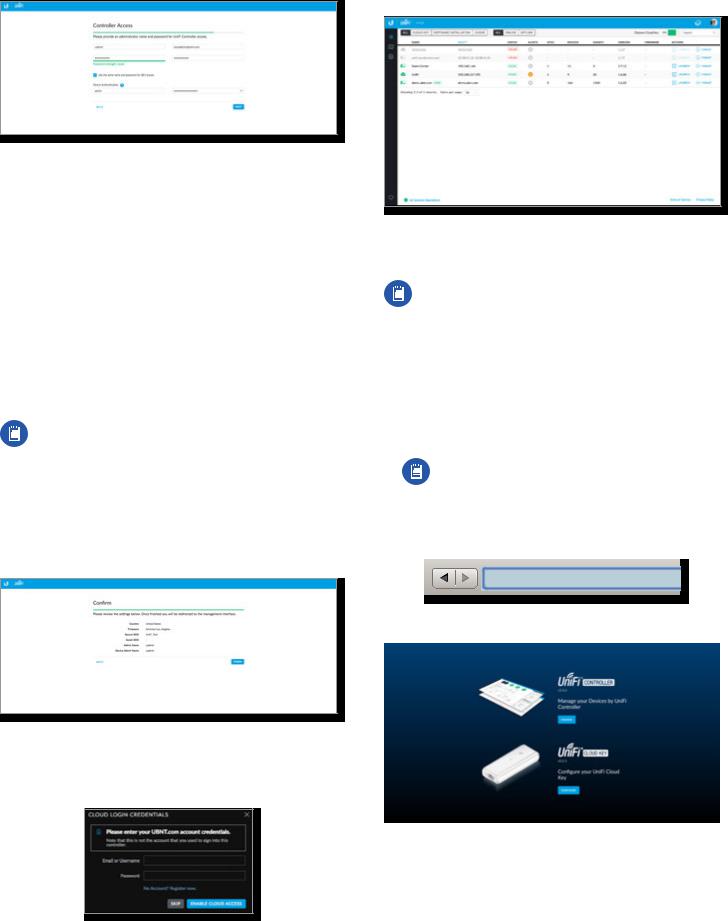
UniFi Controller User Guide
13. Create the superadmin for your UniFi Controller..
Perform the following steps:
a.Enter an admin name in the Admin Name field..
b.Enter an email address in the Admin Email field..
c.Enter a password in the Password field to use when accessing the management interface as a superadmin..
d.Confirm your password in the Confirm Password field..
e.To use the same login for SSH access, select Use the same name and password for SSH access..
f.To set up a separate login for SSH access, enter an admin name and password for the Device Authentication fields..
g.Click Next..
Note: Only the superadmin and admins who have permission to adopt devices can view devices that are Pending Approval and then adopt them on the UniFi Controller.. Ensure that you save the superadmin login information for future use.
14.Review your settings.. Click Finish to save your settings or click Back to make changes.. Once the wizard is finished, the browser will be redirected to the Cloud Login Credentials screen..
15.Enter your Ubiquiti account email/username and password to enable cloud access.. Alternatively, you can click Register now to create a Ubiquiti account.. Click
Enable Cloud Access..
Ubiquiti Networks, Inc.
Chapter 2: UniFi Cloud
16.Wait for the UniFi Controller to be adopted, and then click Launch..
Proceed to “Using the UniFi Controller Software” on page 17 for information on using the UniFi Controller software..
Note: A future feature will enable backup of the UniFi Controller database and configuration on the included microSD card..
Instructions for Other Web Browsers
1.Ensure that your host system is on the same Layer-2 network as the UniFi Cloud Key.
2.The UniFi Cloud Key is set to DHCP by default, so it will try to automatically obtain an IP address.. Assign a specific IP address to the UniFi Cloud Key, or check the DHCP server for its IP address..
Note: The default fallback IP address of the UniFi Cloud Key is 192.168.1.30..
3.Launch the web browser.. In the address field, type https:// followed by the appropriate IP address.. Press enter (PC) or return (Mac)..
4.Click Manage to run the UniFi Setup Wizard..
Note: You can click Configure to change the settings of the UniFi Cloud Key (refer to “UniFi Cloud Key Configuration” on page 9 for
more information).. The default login is ubnt/ubnt or root/ubnt..
7
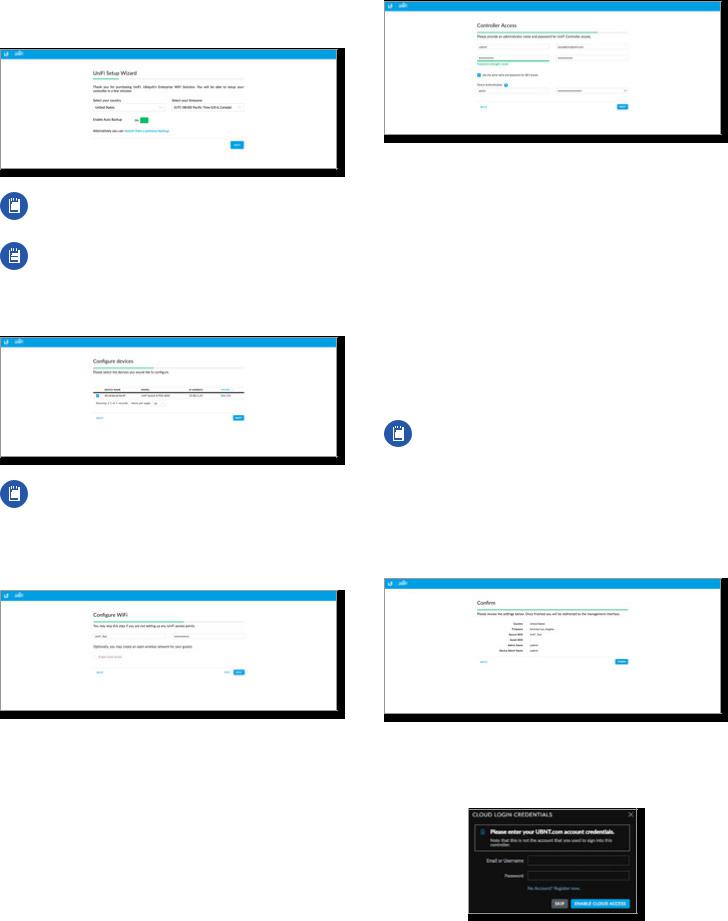
Chapter 2: UniFi Cloud
5.The UniFi Setup Wizard screen appears.. Select your country and time zone.. Alternatively, you can click restore from a previous backup to use a file that contains your backup settings.. Click Next..
Note: Enable Auto Backup is on by default.. Toggle off if you wish to disable..
Note: U..S.. product versions are locked to the U..S.. Country Code to ensure compliance with FCC regulations..
6.Select the devices that you want to configure and click Next..
Note: If there is more than one page of entries to display, click the navigation controls or page
numbers at the bottom right of the screen to display different pages..
7.The UniFi Setup Wizard will create a secure primary wireless network for your devices..
Perform the following steps:
a.Enter the wireless network name (SSID) in the Secure SSID field..
b.Enter a passphrase to be used for your primary network in the Security Key field..
c.To enable guest access, select Enable Guest Access, and enter a guest network name in the Guest
SSIDfield..
d.Click Next..
UniFi Controller User Guide
8. Create the superadmin for your UniFi Controller..
Perform the following steps:
a.Enter an admin name in the Admin Name field..
b.Enter an email address in the Admin Email field..
c.Enter a password in the Password field to use when accessing the management interface as a superadmin..
d.Confirm your password in the Confirm Password field..
e.To use the same login for SSH access, select Use the same name and password for SSH access..
f.To set up a separate login for SSH access, enter an admin name and password for the Device Authentication fields..
g.Click Next..
Note: Only the superadmin and admins who have permission to adopt devices can view devices that are Pending Approval and then adopt them on the UniFi Controller.. Ensure that you save the superadmin login information for future use.
9.Review your settings.. Click Finish to save your settings or click Back to make changes.. Once the wizard is finished, the browser will be redirected to the Cloud Login Credentials screen..
10.Enter your Ubiquiti account email/username and password to enable cloud access.. Alternatively, you can click Register now to create a Ubiquiti account.. Click
Enable Cloud Access..
8 |
Ubiquiti Networks, Inc. |
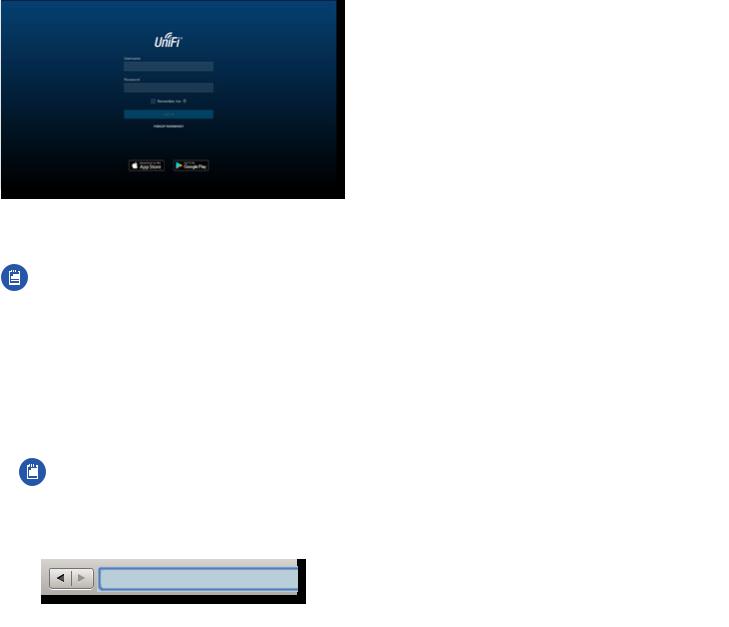
UniFi Controller User Guide
A login screen will appear for the UniFi Controller management interface.. Enter the admin name and password that you created and click Login..
Proceed to “Using the UniFi Controller Software” on page 17 for information on using the UniFi Controller software..
Note: You can back up the UniFi Controller database and configuration on the included microSD card..
UniFi Cloud Key Configuration
Login Instructions
1.Ensure that your host system is on the same Layer-2 network as the UniFi Cloud Key.
2.The UniFi Cloud Key is set to DHCP by default, so it will try to automatically obtain an IP address.. Assign a specific IP address to the UniFi Cloud Key, or check the DHCP server for its IP address..
Note: The default fallback IP address of the UniFi Cloud Key is 192.168.1.30..
3.Launch the web browser.. In the address field, type https:// followed by the appropriate IP address.. Press enter (PC) or return (Mac)..
Chapter 2: UniFi Cloud
4.You have two options:
•Manage Click Manage to access the UniFi Controller.. Proceed to “Using the UniFi Controller Software” on page 17 for more information..
•Configure Click Configure to change the settings of the UniFi Cloud Key..
5.After you click Configure, enter the Username and Password (the default login is ubnt/ubnt).. Then click
Login..
The Main screen will appear..
Ubiquiti Networks, Inc. |
9 |

Chapter 2: UniFi Cloud
Navigation Bar
The UniFi Cloud Key configuration consists of three primary pages:
•“Main” on page 10
•“Configuration” on page 11
•“Maintenance” on page 12
Username
At the top right of each screen, click the Username to display the Change Password, Change Username, and
Logout options:
UniFi Controller User Guide
Change username To change the username, click








 .. The Change Username screen will appear:
.. The Change Username screen will appear:
•New password Enter the new username..
•Submit Click Submit to apply changes..
•Cancel Click Cancel to discard changes..
Logout To manually sign out of the UniFi Cloud Key configuration, click 



 ..
..
Main
The Main screen displays basic status information about the UniFi Cloud Key..
Change password To change the password, click









 .. The Change Password screen will appear:
.. The Change Password screen will appear:
•Old password Enter the current password (the default is ubnt)..
•New password Enter the new password..
•Confirm password Enter the new password again..
•Submit Click Submit to apply changes..
•Cancel Click Cancel to discard changes..
Status
Device Name Displays the hostname or alias of the UniFi Cloud Key..
Uptime Displays the duration of time the UniFi Cloud Key has been running..
Version Displays the version number of the UniFi Cloud Key firmware..
MAC Address Displays the MAC address or hardware identifier of the UniFi Cloud Key..
Date Displays the current date and time..
UniFi
Version Displays the version number of the UniFi Controller software..
Status Displays the status of the UniFi Controller software..
Disk Space
Available Displays the percentage of available disk space.. Used Displays the amount of used disk space..
10 |
Ubiquiti Networks, Inc. |

UniFi Controller User Guide
Free Displays the amount of available disk space.. Total Displays the total amount of disk space..
SD Card
Available Displays the percentage of available space on the SD card..
Used Displays the amount of used space on the SD card..
Free Displays the amount of available space on the SD card..
Total Displays the total amount of space on the SD card..
Configuration
The Configuration screen allows you to configure the basic and network settings of the UniFi Cloud Key..
Basic Settings
Device Name Enter a descriptive name or identifier for the UniFi Cloud Key.. Also known as a host name..
Time Zone Select the appropriate time zone..
Reset Button Use of the hardware Reset button on the UniFi Cloud Key is enabled by default.. To prevent an accidental reset to default settings, click to toggle Off..
Network Settings
Configuration Mode Select the appropriate mode: Static for fixed settings or DHCP for automatic configuration by your DHCP server..
•Static Enter the following information:
-- IP Address Enter the local IP address of the UniFi Cloud Key..
-- Netmask Enter the subnet mask of the UniFi Cloud Key..
-- Gateway Enter the IP address of the network’s gateway router..
-- Primary DNS Enter the IP address of the network’s primary DNS server..
-- Secondary DNS Enter the IP address of the network’s secondary DNS server..
Chapter 2: UniFi Cloud
•DHCP The use of the Dynamic Host Configuration Protocol (DHCP) is the default.. The UniFi Cloud Key automatically acquires network settings from the network’s DHCP server..
-- Fallback IP Address Enter the IP address for the UniFi Cloud Key to use if an external DHCP server is not found..
-- Fallback Netmask Enter the netmask for the UniFi Cloud Key to use if an external DHCP server is not found..
Apply Changes Click Apply Changes to save changes..
Discard Click Discard to cancel changes..
Ubiquiti Networks, Inc. |
11 |

Chapter 2: UniFi Cloud
Maintenance
The Maintenance screen contains administrative options, so you can change the password, reboot the UniFi Cloud Key, power it off, reset it to factory defaults, restore the UniFi Controller software, upgrade the UniFi Cloud Key firmware, or upgrade the UniFi Controller software..
Security
Password To change the password, click Change Password.. The Change Password screen will appear:
•Old password Enter the current password (the default is ubnt)..
•New password Enter the new password..
•Confirm Password Enter the new password again..
•Submit Click Submit to apply changes..
•Cancel Click Cancel to discard changes..
Username To change the username, click Change Username.. The Change Username screen will appear:
•New username Enter the new username..
•Submit Click Submit to apply changes..
•Cancel Click Cancel to discard changes..
UniFi Controller User Guide
Maintenance
Reboot Click Reboot to powercycle the UniFi Cloud Key.. Power Off Click Power Off to turn off the UniFi Cloud Key..
Reset to Defaults Click Reset to Defaults to reset the UniFi Cloud Key to its factory default settings.. This option will reboot the UniFi Cloud Key, and all factory default settings will be restored..
Note: We recommend that you back up your UniFi Controller configuration (refer to “Backup” on page 60 for more information) before resetting the
UniFi Cloud Key to its defaults..
Restore
Service While the UniFi Controller software is running, click Stop UniFi to stop it.. To restart the software, click Start UniFi to restart it..
Restore from file Click Choose File to restore the UniFi Controller from a file you specify.. Follow the on-screen instructions..
Auto Backup
Restore from Auto Backup Click to restore from the automatic backup file.. Follow the on-screen instructions..
Firmware
Version Displays the version number of the UniFi Cloud Key firmware..
Check for Updates Click Check for Updates to see if there is a newer firmware version.. If there is, then you can follow the on-screen instructions to upgrade now..
Update Manually Click Update Manually to update the firmware.. The Please Confirm Update screen will appear..
You have two options:
•upload file If you have the firmware saved in a specific location, then click Select File to browse for the file..
12 |
Ubiquiti Networks, Inc. |
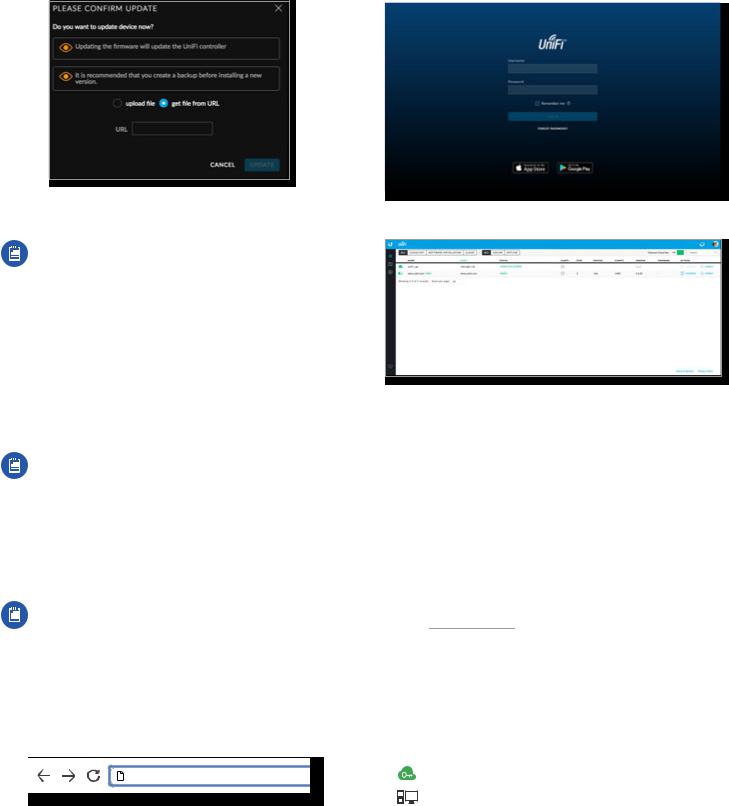
UniFi Controller User Guide
•get file from URL If you know the URL of the firmware’s location, then enter it in the URL field..
•Update Click Update to proceed with the update..
•Cancel Click Cancel to skip the update..
Note: Updating the UniFi Cloud Key firmware will also update the UniFi Controller software.. We recommend that you back up your UniFi Controller configuration (refer to “Backup” on page 60 for more information) before updating the UniFi Cloud Key firmware..
UniFi
Version Displays the version number of the UniFi Controller software..
Check for Updates Click Check for Updates to see if there is a newer software version.. If there is, then you can follow the on-screen instructions to upgrade now..
Note: We recommend that you back up your UniFi Controller configuration (refer to “Backup” on page 60 for more information) before upgrading the UniFi Controller software..
UniFi Cloud Account
You must be a superadmin for initial cloud management.. Once cloud access is enabled by the superadmin, then any other admin can also enable cloud access..
Note: The cloud account is also known as the Single Sign-On (SSO) account..
Login Instructions
1.Launch the Chrome web browser and type https:// followed by the appropriate Controller Hostname/IP address as specified in “Settings > Controller” on page 56.. Press enter (PC) or return
(Mac)..
https://unifi.ubnt.com
Ubiquiti Networks, Inc.
Chapter 2: UniFi Cloud
2.Enter the username and password for your UBNT account.. Click Sign In..
A list of UniFi Controllers will appear..
You can apply one of the following primary filters:
•All Displays all UniFi Controllers..
•Cloud Key Only displays UniFi Cloud Keys..
•Software Installation Only displays instances of software installations..
•Cloud Only displays UniFi Controllers with cloud access.. A secondary filter is available:
•All Displays all UniFi Controllers..
•Online Only displays online UniFi Controllers..
•Offline Only displays offline UniFi Controllers..
Discover Cloud Key Click to discover a UniFi Cloud Key on your local network..
Search  Enter the text you want to search for.. Simply begin typing; there is no need to press Enter..
Enter the text you want to search for.. Simply begin typing; there is no need to press Enter..
You can click any of the column headers to change the list order.
(icon) Displays the icon corresponding to the device running the UniFi Controller.. Green indicates an active UniFi Controller.. Gray indicates an inactive UniFi Controller..
UniFi Cloud Key
Computer
Name Displays the hostname, alias, or MAC address of the device running the UniFi Controller.. You can click the name to get additional details at the bottom of the screen.. (Go to “Additional Details” on page 15 for more information..)
13
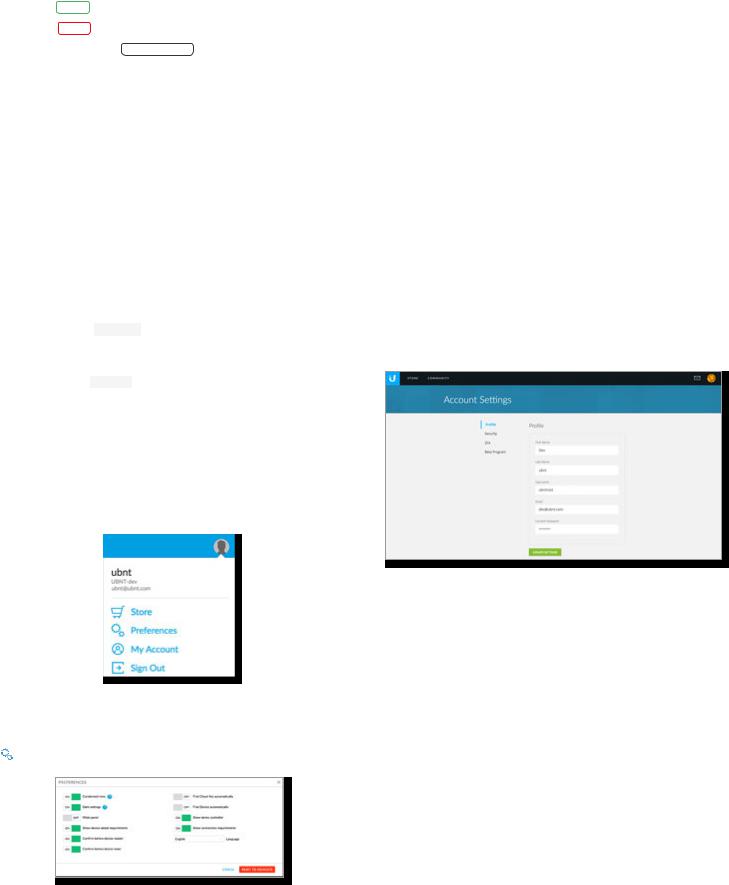
Chapter 2: UniFi Cloud
Host Displays the IP address of the device running the UniFi Controller..
Status Displays the status of the UniFi Controller:
•Online ONLINE The UniFi Controller is available for access..
•Offline OFFLINE The UniFi Controller is not available..
•Manage By Other MANAGE BY OTHER The UniFi Controller is not available because it is managed by another admin..
Alerts Displays the number of alerts for the UniFi Controller..
Sites Displays the total number of sites managed by the UniFi Controller..
Devices Displays the total number of devices managed by the UniFi Controller..
Clients Displays the total number of clients on the sites managed by the UniFi Controller..
Version Displays the software version number of your UniFi Controller..
Firmware Displays the firmware version number, if available..
Actions Click a button to perform the desired action:
•Launch Click  LAUNCH to access the UniFi Controller.. Proceed to “Using the UniFi Controller Software” on page 17 for more information..
LAUNCH to access the UniFi Controller.. Proceed to “Using the UniFi Controller Software” on page 17 for more information..
•Forget Click  FORGET to remove the UniFi Controller from your cloud account..
FORGET to remove the UniFi Controller from your cloud account..
Chat At the lower left of the screen, click  to open a window for online chat support..
to open a window for online chat support..
Admin
At the top right of the screen, click the account icon
( by default or the user-specified icon) to display the
by default or the user-specified icon) to display the
Preferences, My Account and Sign Out options:
Store Click


 to access the store site for UniFi products..
to access the store site for UniFi products..
Preferences To change your account preferences, click





 .. The Preferences screen will appear:
.. The Preferences screen will appear:
14
UniFi Controller User Guide
The available settings are:
•Condensed view Enabled by default.. The table padding is condensed and the font size is minimized to fit as much data on the screen as possible..
•Dark settings Enabled by default.. A dark theme is used on the Settings screens..
•Wide panel Disabled by default.. If enabled, the Details panel is displayed with maximum width..
•Show device adopt requirements Enabled by default..
•Confirm before device restart Enabled by default..
•Confirm before device reset Enabled by default..
•Find Cloud Key automatically Disabled by default..
•Find Device automatically Disabled by default..
•Show Demo Controller Enabled by default..
•Show connection requirements Enabled by default..
•Language The default is English..
Your changes are automatically saved.. To cancel changes, click Cancel.. To reset to factory default settings, click
Reset to Defaults..
My Account To change your account settings and/or password, click  .. The Account Settings screen will appear:
.. The Account Settings screen will appear:
There are four pages available:
•Profile Access your account settings: -- First Name Enter your first name.. -- Last Name Enter your last name..
-- Username Enter your login username..
-- Email Enter the email address of your cloud account..
-- Current Password Enter your current account password..
-- Update Settings Click to apply your changes..
•Security Change the duration of your session and/or your account password:
-- Session Timeout Select the appropriate duration of your session.. You will be automatically logged out for security purposes..
-- Update Session Settings Click to apply your changes..
Ubiquiti Networks, Inc.
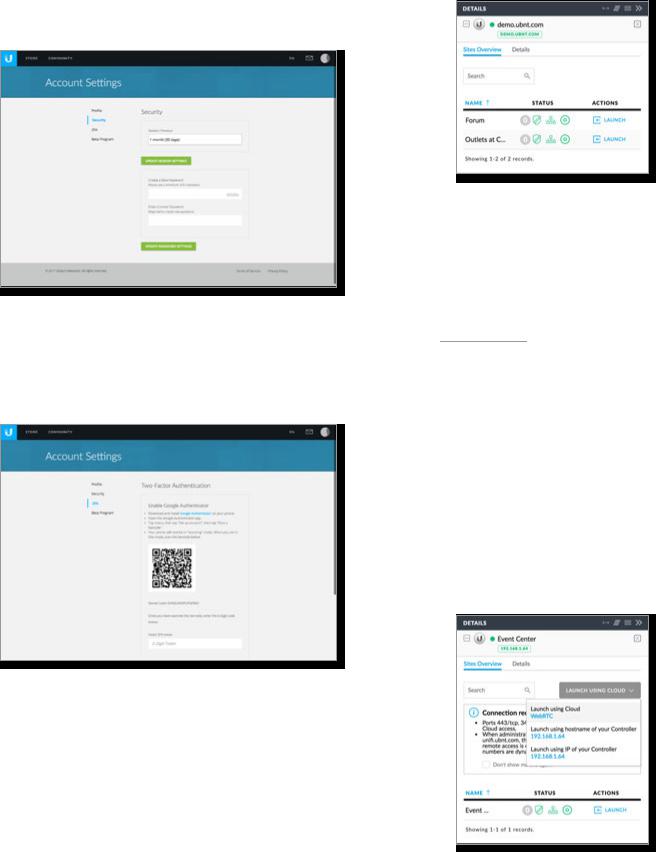
UniFi Controller User Guide
-- Create a New Password Enter a new password with at least eight characters..
-- Enter Current Password Enter your current account password..
-- Update Password Settings Click to apply your changes..
•2FA Follow the on-screen instructions if you want to use the Google Authenticator app for two-factor authentication (2FA)..
-- Insert 2FA token Enter the 6-digit code after you have scanned the on-screen QR code..
-- Enable 2FA Click to apply the code..
•Beta Program Follow the on-screen instructions if you want to join the beta program..
-- I agree to the Terms of Service & Beta Program Guidelines Select to agree to the terms and guidelines for joining the beta program..
-- Join Now Click to join the beta program..
Sign Out To manually sign out of the cloud account, click
 ..
..
Chapter 2: UniFi Cloud
Additional Details
Select a UniFi Controller to display more information on the right side of the screen..
•(icon) A green circle icon  indicates an active UniFi Controller.. Gray indicates an inactive UniFi Controller..
indicates an active UniFi Controller.. Gray indicates an inactive UniFi Controller..
•(controller_name) Displays the Controller Hostname/IP address as specified in “Settings > Controller” on page 56..
•IP Address Displays the IP address of the device running the UniFi Controller..
Sites Overview
•Search  Enter the text you want to search for.. Simply begin typing; there is no need to press
Enter the text you want to search for.. Simply begin typing; there is no need to press
Enter..
•Launch Using Cloud If cloud access is available, then you can use it to access the UniFi Controller.. Click the appropriate option: Launch using Cloud, Launch using hostname of your Controller, or Launch using IP of your Controller..
For cloud access, these are the requirements:
•Ports 443 (TCP), 3478 (UDP), and 443 (UDP) must be open..
•If you access this Controller using unifi..ubnt..com, there will be some outbound UDP traffic if remote access
is ongoing (via WebRTC), and the port numbers are dynamic..
Ubiquiti Networks, Inc. |
15 |
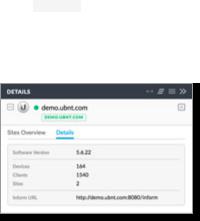
Chapter 2: UniFi Cloud |
UniFi Controller User Guide |
•Name Displays the name of the site.. You can click the name to get additional details on the right..
•Status Indicates the number of alerts and status of each dashboard node..
-- (Unread Alerts)  Displays the number of unread alerts..
Displays the number of unread alerts..
-- (WAN/LAN/WLAN) The status of each dashboard node: UniFi Security Gateway, UniFi wired network, or UniFi wireless network is indicated by color:
•Green Indicates an active node..
•Red Indicates that the node or some of its devices are offline..
•Gray Gray indicates that there is no connection or there are no devices available for that node.
•Actions Click a button to perform the desired action:
-- Launch Click  LAUNCH to access the UniFi Controller.. Proceed to “Using the UniFi Controller Software” on page 17 for more information..
LAUNCH to access the UniFi Controller.. Proceed to “Using the UniFi Controller Software” on page 17 for more information..
Details
•Software Version Displays the software version number of the UniFi Controller..
•Devices Displays the total number of devices managed by the UniFi Controller..
•Clients Displays the total number of clients on the sites managed by the UniFi Controller..
•Sites Displays the total number of sites managed by the UniFi Controller..
•Inform URL Displays the URL, port, and path to the UniFi Controller.. This tells UniFi APs where to look for the UniFi Controller..
16 |
Ubiquiti Networks, Inc. |
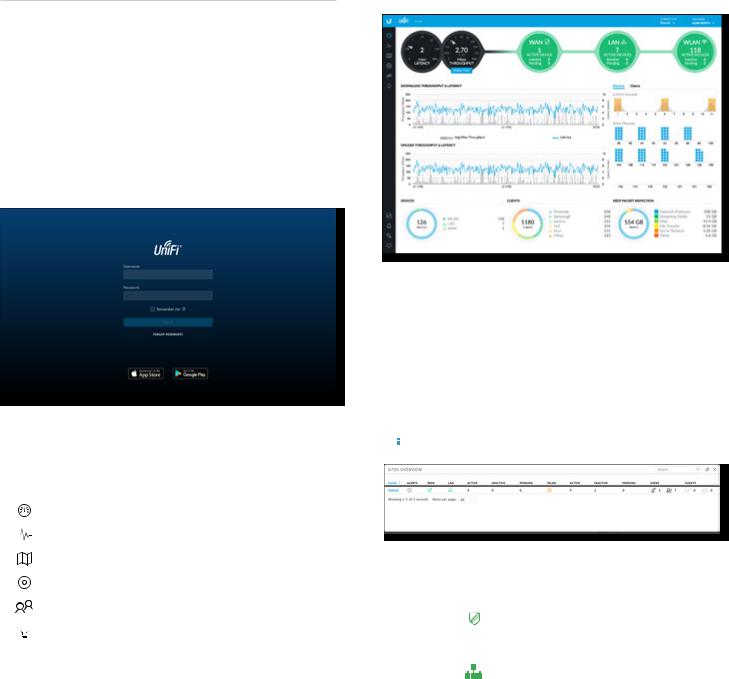
UniFi Controller User Guide
Chapter 3: Using the UniFi
Controller Software
The UniFi Controller software has a browser-based interface for easy configuration and management..
To access the interface, perform the following steps:
1.Launch the UniFi Controller application if it hasn’t already been started..
•Mac users: Go > Applications > UniFi
•Windows users: Start > All Programs >
Ubiquiti UniFi
2.The UniFi login screen will appear.. Enter the username and password in the appropriate fields and click Log In..
Chapter 3: Using the UniFi Controller Software
Common Interface Options
The common interface options are accessible from all tabs in the UniFi interface..
Navigation Bar
The UniFi software consists of six primary pages.. This User Guide covers each page with a chapter.. For details on a specific page, refer to the appropriate chapter..
“Dashboard” on page 63 “Statistics” on page 71 “Map” on page 81 “Devices” on page 89 “Clients” on page 99 “Insights” on page 105
Current Site
The UniFi Controller can manage multiple UniFi networks, which are called sites.. Each site has its own configurations, maps, statistics, guest portals, and site administrator accounts.. The multiple sites are logically separated, and the initial site is named Default..
Current Site To view available sites or create a new site, click the arrow  icon..
icon..
•Sites overview To display a list of available sites, click
 Sites overview.. The Sites Overview screen will appear..
Sites overview.. The Sites Overview screen will appear..
Each site is displayed with the following: -- Name Displays the name of the site..
-- Alerts Displays the number of pending alerts..
-- WAN The |
|
icon is color-coded to display the |
WAN connection status.. Green indicates active; red |
||
indicates inactive.. |
||
-- LAN The |
|
icon is color-coded to display the wired |
|
||
network connection status.. Green indicates active; red indicates inactive..
-- Active Displays the number of active wired devices..
-- Inactive Displays the number of inactive wired devices..
-- Pending Displays the number of wired devices pending adoption..
-- WLAN The  icon is color-coded to display the wireless network connection status.. Green indicates active; red indicates inactive..
icon is color-coded to display the wireless network connection status.. Green indicates active; red indicates inactive..
Ubiquiti Networks, Inc. |
17 |
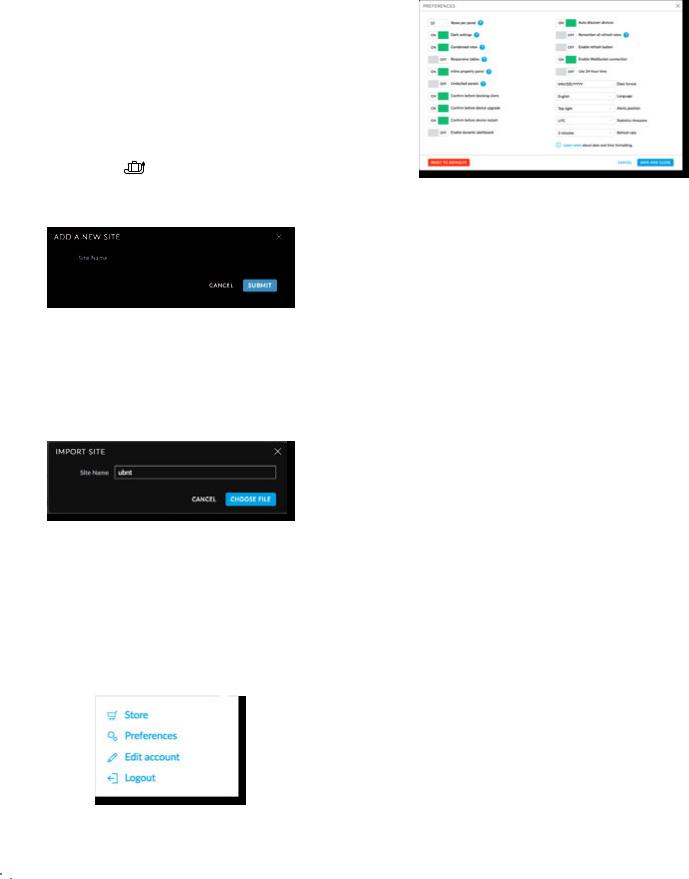
Chapter 3: Using the UniFi Controller Software
-- Active Displays the number of active wireless devices..
-- Inactive Displays the number of inactive wireless devices..
-- Pending Displays the number of wireless devices pending adoption..
-- Users Displays the number of wireless users  and wired users
and wired users  ..
..
-- Guests Displays the number of wireless guests 
and wired guests |
.. |
•Add new site To create a new site, click  Add new site , and the Add a New Site screen will appear:
Add new site , and the Add a New Site screen will appear:
-- Site Name Enter a name that describes the site.. It will be used in the Current Site drop-down menu..
-- Cancel Click to discard changes.. -- Submit Click to save changes..
•Import Site Click to import a new site.. The Import Site screen will appear..
-- Site Name Enter a name that describes the site.. It will be used in the Current Site drop-down menu..
-- Choose File Browse for the appropriate file.. -- Cancel Click to discard changes..
Username
At the top right of the screen, click the Username to display the Store, Preferences, Edit Account, and Logout options:
Store If enabled by the admin, there is a direct link to: store.ubnt.com
Preferences To change the UI settings, click







 ..
..
UniFi Controller User Guide
•Rows per panel Displays the number of rows per page for tables in the property panels.. The default is 10..
•Dark settings Enabled by default.. A dark theme is used on the Settings screens..
•Condensed view Enabled by default.. The table padding is condensed and the font size is minimized to fit as much data on the screen as possible..
•Responsive tables Disabled by default.. If enabled, the Responsive tables option removes columns on smaller sized browsers to prevent excessive scrolling when the table columns are not customized..
•Inline property panel Enabled by default.. When the property panel is inline, it compresses the main content when it is open.. When the property panel is not inline, it opens on top of the content, as a popup..
•Undocked panels Disabled by default.. Properties appear as overlays instead of in the property panel..
•Confirm before blocking client Enabled by default..
•Confirm before device upgrade Enabled by default..
•Confirm before device restart Enabled by default..
•Enable dynamic dashboard Disabled by default.. If you enable it, then you can customize the Dashboard display.. For more information, go to “Dynamic Dashboard (beta)” on page 69..
•Auto discover devices Enabled by default.. Devices are automatically discovered..
•Remember all refresh rates Disabled by default.. Quick refresh rates are not recommended for permanent use or large installations..
•Enable refresh button Disabled by default.. If enabled, the refresh button is displayed..
•Enable WebSocket connection Enabled by default.. WebSocket allows cloud access..
•Use 24-hour time Disabled by default..
•Date format Enter the format you want to use.. The default is MM/DD/YYYY..
•Language Select the appropriate language..
•Alerts position Select the position you want alerts to appear: Top left, Top center, Top right, Bottom left, Bottom center, or Bottom right..
18 |
Ubiquiti Networks, Inc. |
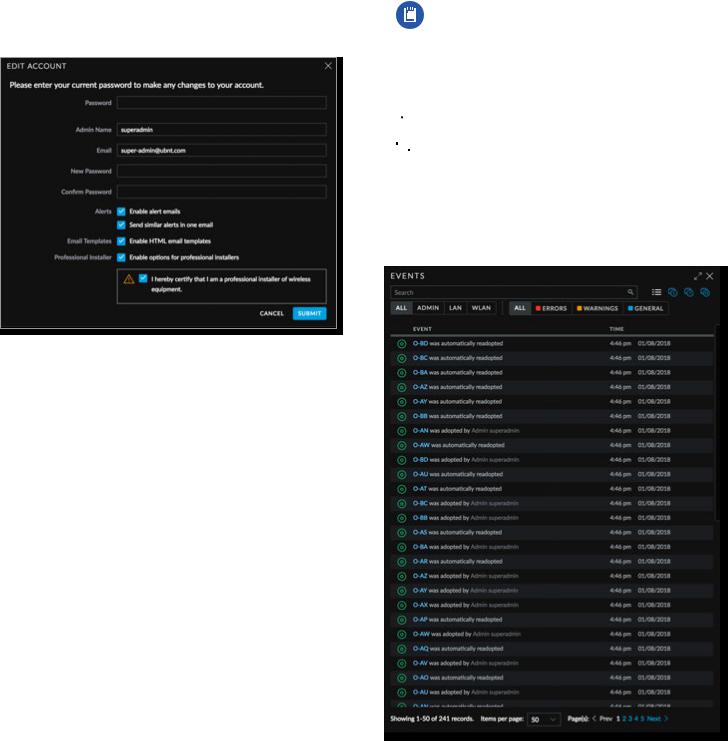
UniFi Controller User Guide
•Statistics timezone Select the appropriate time zone for logging the statistical data: Browser’s, Site’s, or UTC.. The default is UTC..
•Refresh rate The default is 2 minutes..
•Cancel Click to discard changes..
•Save and Close Click to save changes..
•Reset to Defaults Click to reset to factory defaults..
Edit Account To change the login name and/or password, click 





 .. The Edit Account screen will appear:
.. The Edit Account screen will appear:
•Password Enter your current password..
•Admin Name Enter the admin name..
•Email Enter the email address of the admin account..
•New Password Enter the new password..
•Confirm Password Enter the new password again..
•Alerts Select this option to enable email notifications..
-- Send similar alerts in one email Select this option to group similar alerts in a single email notification..
•Email Templates Select this option to enable the use of HTML email templates..
•Professional Installer Select this option to enable options for professional installers.. Then select I hereby certify that I am a professional installer of wireless equipment.. (This allows you to set the antenna gain for the UAP AC M device, which has a detachable antenna..)
•Submit Click to apply changes..
•Cancel Click to discard changes..
Logout To manually sign out of the UniFi Configuration Interface, click 



 ..
..
Properties
The Properties panel is hidden by default.. To display it, select a device..
Information about each selected device appears as a popup within this panel.. The information varies
Chapter 3: Using the UniFi Controller Software
depending on the device type.. For more information, see the appropriate chapter:
•“UniFi Security Gateway Details” on page 115
•“UniFi Switch Details” on page 121
•“UniFi Access Point Details” on page 131
•“Client Details” on page 147
Note: For management of the UniFi VoIP Phones, please download the UniFi VoIP Controller: www.ubnt.com/download/unifi
Controls and Live Chat
At the bottom left of the screen, there are four controls:
• Events
Events
• Alerts (see “Alerts” on page 20)
Alerts (see “Alerts” on page 20)
•


 Settings (see “Settings” on page 21)
Settings (see “Settings” on page 21)
• Chat with Us (see “Chat with Us” on page 62)
Chat with Us (see “Chat with Us” on page 62)
Events
The Events  tab displays a list of recent events, along with the corresponding device icon, device name, message, date, and time..
tab displays a list of recent events, along with the corresponding device icon, device name, message, date, and time..
Maximize/Minimize Click 
 to maximize the screen size.. Click again to minimize the screen size..
to maximize the screen size.. Click again to minimize the screen size..
Close Click  to close the screen..
to close the screen..
Ubiquiti Networks, Inc. |
19 |
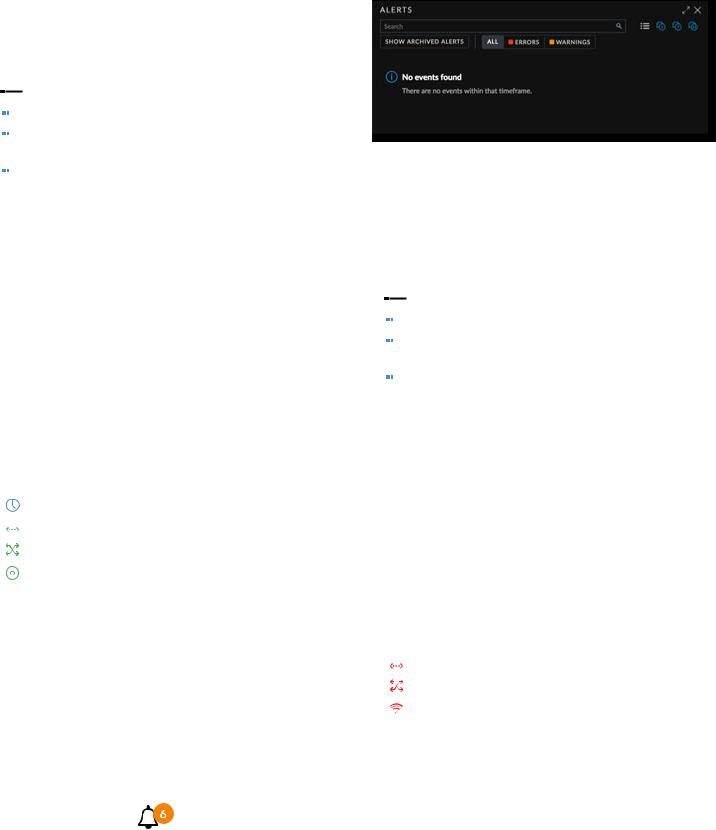
Chapter 3: Using the UniFi Controller Software
Search You can enter text that you want to search for.. Simply begin typing; there is no need to press Enter..
You can enter text that you want to search for.. Simply begin typing; there is no need to press Enter..
You can apply one of the following filters to filter recent events based on the time period you specify:
•
 (All) Display all of the recent events..
(All) Display all of the recent events..
•
 (1 day) Filter recent events for a one-day duration..
(1 day) Filter recent events for a one-day duration..
•
 (7 days) Filter recent events to display a week’s duration..
(7 days) Filter recent events to display a week’s duration..
•
 (31 days) Filter recent events to display a month’s duration..
(31 days) Filter recent events to display a month’s duration..
You can apply one of the following filters:
•All Display all of the recent events..
•Admin Only display recent events for the administrator..
•LAN Only display recent events for the wired network..
•WLAN Only display recent events for the wireless networks..
You can apply one of the following filters:
•All Display all of the recent events..
•Error Only display error-level events..
•Warnings Only display warning-level events..
•General Only display general-level events..
Icons
The messages use the following icons (not all are shown here):
Scheduled for upgrade
UniFi Security Gateway
UniFi Switch
UniFi Access Point
Clicking an Event Device Link
The messages have clickable links for client and UniFi devices:
•“UniFi Security Gateway Details” on page 115
•“UniFi Switch Details” on page 121
•“UniFi Access Point Details” on page 131
•“Client Details” on page 147
Alerts
When there is a new alert, an orange icon displaying the number of new alerts appears..
The Alerts  tab displays a list of important events, along with the corresponding device icon, device name, message, date, and time.
tab displays a list of important events, along with the corresponding device icon, device name, message, date, and time.
UniFi Controller User Guide
Maximize/Minimize Click 
 to maximize the screen size.. Click again to minimize the screen size..
to maximize the screen size.. Click again to minimize the screen size..
Close Click  to close the screen..
to close the screen..
Search You can enter text that you want to search for.. Simply begin typing; there is no need to press Enter..
You can enter text that you want to search for.. Simply begin typing; there is no need to press Enter..
You can apply one of the following filters to filter recent alerts based on the time period you specify:
•
 (All) Display all of the recent alerts..
(All) Display all of the recent alerts..
•
 (1 day) Filter recent alerts for a one-day duration..
(1 day) Filter recent alerts for a one-day duration..
•
 (7 days) Filter recent alerts to display a week’s duration..
(7 days) Filter recent alerts to display a week’s duration..
•
 (31 days) Filter recent alerts to display a month’s duration..
(31 days) Filter recent alerts to display a month’s duration..
Show archived alerts Select this option to display all of the archived alert messages..
You can apply one of the following filters:
•All Display all of the recent events..
•Error Only display error-level events..
•Warnings Only display warning-level events..
Archive All Click Archive All to archive all of the alert messages..
Archive Click  to archive the selected alert message..
to archive the selected alert message..
Icons
The messages use the following icons (not all are shown here):
UniFi Security Gateway
UniFi Switch
UniFi Access Point
Clicking an Alert Device Link
The messages have clickable links for client and UniFi devices:
•“UniFi Security Gateway Details” on page 115
•“UniFi Switch Details” on page 121
•“UniFi Access Point Details” on page 131
•“Client Details” on page 147
20 |
Ubiquiti Networks, Inc. |

UniFi Controller User Guide
Settings
The Settings 

 tab displays a list of available sub tabs:
tab displays a list of available sub tabs:
•“Settings > Site” on page 21
•“Settings > Wireless Networks” on page 22
•“Settings > Networks” on page 27
•“Settings > Routing & Firewall” on page 31
•“Settings > Guest Control” on page 37
•“Settings > Profiles” on page 45
•“Settings > Services” on page 48
•“Settings > Admins” on page 53
•“Settings > User Groups” on page 54
•“Settings > DPI” on page 55
•“Settings > Controller” on page 56
•“Settings > Notifications” on page 57
•“Settings > Cloud Access” on page 58
•“Settings > Elite” on page 59
•“Settings > Maintenance” on page 59
•“Settings > Auto Backup” on page 62
Settings > Site
Configure the site-specific settings.. To switch sites, select a different site from the Current Site drop-down menu at the top of any screen..
Site Configuration
Site Name Change the name of the site.. Country Select the appropriate country.. Time Zone Select the appropriate time zone..
Services
Advanced Features When enabled, airtime fairness, bandsteering, minimum RSSI, and load balancing features become available..
Automatic Upgrade When enabled, the UniFi Controller will automatically upgrade your APs’ firmware when an update is available..
Ubiquiti Networks, Inc.
Chapter 3: Using the UniFi Controller Software
LED When enabled, the status LEDs on the UniFi devices will light up.. When disabled, the LEDs will turn off..
Alerts Select this option to enable alert emails, which will be sent to the email addresses of the administrators..
Speed Test When enabled, you can run a periodic speed test.. Enter the interval in minutes..
Port Remapping When enabled, the VOIP port on the UniFi Security Gateway, model USG, will be remapped as a WAN2 port..
Uplink Connectivity Monitor It monitors the uplinks of the managed APs, either wired or wireless, by checking to see if the gateway/custom IP can be reached..
•Enable connectivity monitor and wireless uplink The monitor and wireless uplink capability are enabled by default..
-- Enable automatic uplink failover Enable this option to have the UniFi Controller automatically select a new wireless uplink if the original uplink fails.. This allows the UniFi APs to switch to alternative uplinks/mesh configurations if a node fails..
•Default Gateway Enabled by default.. All managed APs will use the gateway of the AP that is providing IP information, either by DHCP or Static designation..
•Custom IP Click to specify an IP address..
-- Uplink IP Address All managed APs will use the IP address you enter..
SNMP Select this option to activate the SNMP (Simple Network Monitor Protocol) agent.. SNMP is an application layer protocol that facilitates the exchange of management information between
network devices.. Network administrators use SNMP to monitor network attached devices for issues that warrant attention.
•Community String Specify the SNMP community string.. It is required to authenticate access to MIB (Management Information Base) objects and functions as an embedded password.. The device supports a read-only community string; authorized management stations have read access to all the objects in the MIB except the community strings, but do not have write access.. The device supports SNMP v1.. The default
is public..
Remote Logging Enable to define a remote syslog server..
•Enable debug logging Select this option to create debug logs..
•Remote IP or Hostname Enter the IP address or hostname of the syslog server..
•Port Enter the port number of the syslog server.. The default is 514..
Device Authentication
SSH Authentication This option protects SSH access to the UniFi devices.. All devices in the same site share the same SSH username and password.. You can also make changes:
21

Chapter 3: Using the UniFi Controller Software
•Username Enter the new username..
•Password Enter the new password.. Apply Changes Click to save changes.. Reset Click to cancel changes..
Export Site Click to export the site to another controller of the same or higher version number.. Then follow the on screen instructions..
•Download Backup File Click to download a backup configuration file..
•Cancel Click to cancel the export..
Settings > Wireless Networks
Configure the wireless networks for each site.. You can have up to four wireless network names or SSIDs per
WLAN group.
WLAN Group The Default WLAN group is automatically created..
Add a New WLAN Group To add a new WLAN group, click the  button.. Go to the Add or Edit a WLAN Group section..
button.. Go to the Add or Edit a WLAN Group section..
Add or Edit a WLAN Group
•Name Enter or edit a descriptive name for the WLAN group..
UniFi Controller User Guide
•Mobility To enable seamless roaming (Zero Handoff), select the checkbox..
Note: Not all UniFi APs support Zero Handoff Roaming..
When you enable this option, multiple Access Points (APs) act as an AP cluster, appearing as a single AP.. The wireless client detects only one AP, so it seamlessly roams from AP to AP – there is no need to re-negotiate.. The APs determine which AP has the best connection and should serve the client.. They use multicasting to communicate so they must be wired in the same Layer 2 domain..
Zero Handoff Roaming does not support wireless uplinks and can only be used on a secured network.. It is also not meant for all scenarios.. For example, if there is too much load or interference, then Zero Handoff Roaming may not be appropriate for your scenario..
Configure the following options:
-- Radio Select the appropriate radio, 2G or 5G..
-- Channel Select the channel that all of the APs will use for Zero Handoff Roaming..
•Legacy Support (Not available if you enabled the Mobility option..) By default, legacy devices, such as 802..11b devices, are excluded.. Select this option if you want to support legacy devices..
Advanced Options Click to display more options..
22 |
Ubiquiti Networks, Inc. |
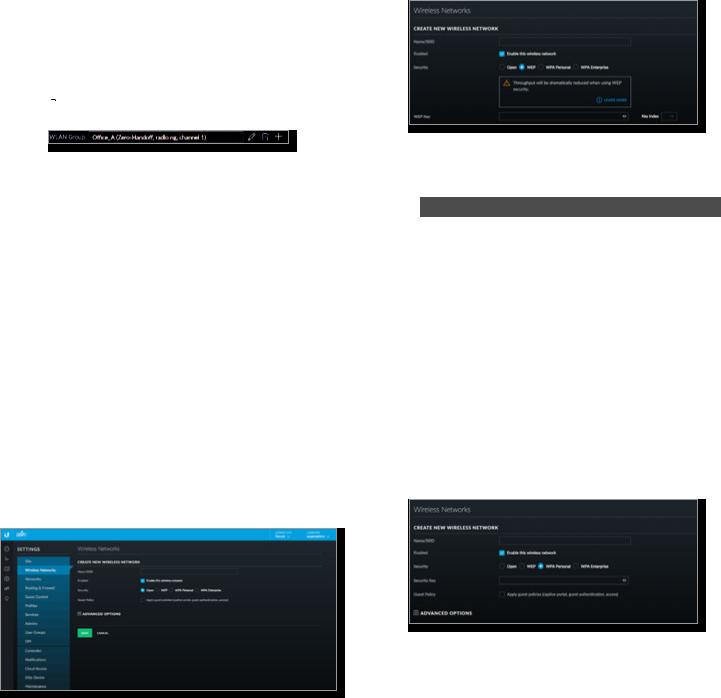
UniFi Controller User Guide
•PMF Enabling PMF (Protected Management Frames) may cause a drop in performance.. Select the appropriate option:
-- Disabled The UniFi APs will not use PMF for any stations..
-- Optional The UniFi APs will use PMF for all PMFcapable stations while allowing non-PMF-capable stations to join the wireless network..
-- Required The UniFi APs will use PMF for all stations.. Stations that are not capable of PMF will not be allowed to join the wireless network..
Save Click to apply changes..
Cancel Click to discard changes..
For each WLAN group, you have the following:
•Remove a WLAN Group To remove a WLAN group (except for the Default, which cannot be removed), select it from the drop-down menu, and then click the delete  button..
button..
•Options To make changes, select the WLAN group from
the drop down menu, and then click the edit  button.. Go to “Add or Edit a WLAN Group” on page 22..
button.. Go to “Add or Edit a WLAN Group” on page 22..
Wireless Networks
Name Displays the wireless network name or SSID..
Security Displays the type of security being used on your wireless network..
Guest Network Indicates whether or not the network is a guest network..
VLAN Indicates its VLAN ID..
Actions Click a button to perform the desired action:
• Edit Click  EDIT to make changes to the wireless network settings.. Go to the Create or Edit a Wireless Network section..
EDIT to make changes to the wireless network settings.. Go to the Create or Edit a Wireless Network section..
• Delete Click 


 to remove the wireless network..
to remove the wireless network..
Create Wireless Network Click  to add a wireless network.. Go to the Create or Edit a Wireless Network section..
to add a wireless network.. Go to the Create or Edit a Wireless Network section..
Create or Edit a Wireless Network
Chapter 3: Using the UniFi Controller Software
•Name/SSID Enter or edit the wireless network name or SSID.
•Enabled Select this option to make the network active..
•Security Select the type of security to use on your wireless network..
-- Open This option is typically only used on the guest network.. When enabled, wireless network access is open to anyone without requiring a password..
-- WEP WEP (Wired Equivalent Privacy) is the oldest and least secure security algorithm.. WPA™ security methods should be used when possible..
•WEP Key Enter a WEP encryption key in hexadecimal format.. You can enter a 64-bit or 128 bit key:
Type |
Hex |
|
|
64-bit |
10 Hexadecimal Characters |
|
(0-9, A-F, or a-f) |
|
Example: 00112233AA |
|
Note: You can use 5 printable characters, which |
|
will be translated to the corresponding HEX code. |
|
|
128-bit |
26 Hexadecimal Characters |
|
(0-9, A-F, or a-f) |
|
Example: 00112233445566778899AABBCC |
|
Note: You can use 13 printable characters, which |
|
will be translated to the corresponding HEX code. |
|
|
•Key Index Specify which Index of the WEP Key to use.. Four different WEP keys can be configured at the same time, but only one is used.. Select the effective key: 1, 2, 3, or 4..
-- WPA-Personal WPA or Wi-Fi Protected Access was developed as an encryption method stronger than WEP.. WPA-Personal requires a passphrase to connect to the wireless network..
•Security Key Enter the passphrase that users will use to connect to the wireless network..
Ubiquiti Networks, Inc. |
23 |
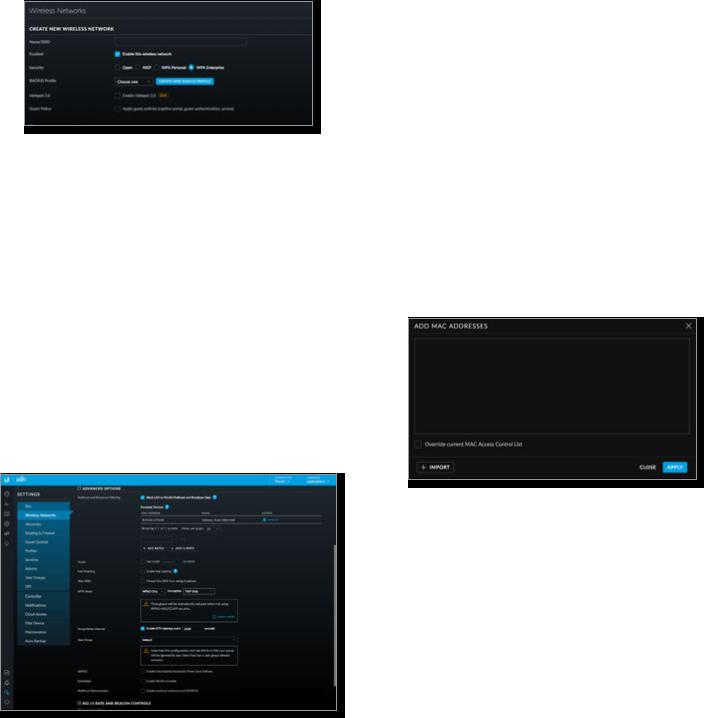
Chapter 3: Using the UniFi Controller Software
-- WPA-Enterprise WPA Enterprise uses a RADIUS server to authenticate users on the wireless network..
•RADIUS Profile Specify a RADIUS profile:
•Select a RADIUS profile from the drop-down list, or
•Click Create New RADIUS Profile to create a new RADIUS profile.. Refer to “Create or Edit a RADIUS Profile” on page 45 for detailed information..
•Hotspot 2.0 Select this option to enable Hotspot 2..0.. Then select a Hotspot profile from the drop down list.. Go to “Hotspot 2.0” on page 49 for more information..
•Guest Policy Select this option to enable guest access policies on this wireless network.. By default, guest policies will drop broadcast traffic from wireless stations and also block LAN => WAN broadcast and multicast data from all except the default gateway.. See Advanced Options for custom whitelisting..
Advanced Options
Click to display options for advanced users..
•Multicast and Broadcast Filtering Disabled by default.. We recommend to enable it if there are more than 100 wireless clients on a single Layer-2 network.. When Multicast and Broadcast Filtering is enabled, devices such as Chromecasts and Apple TVs will not be discovered unless the USG MDNS service is enabled..
UniFi Controller User Guide
Multicast/broadcast data is sent out at the lowest modulation rate, so we recommend that you block this traffic unless it is absolutely essential.. Disable this option if proper multicast/broadcast controls are already implemented on the LAN infrastructure..
-- Excepted Devices You can specify devices that need to send multicast/broadcast data to Wi-Fi stations.. In most cases, only the default gateway needs to send multicast data to Wi-Fi stations and is automatically added by the UniFi Controller.. You can add any other devices, such as Bonjour printers or Chromecast devices..
•MAC Address Displays the MAC address of the device..
•Name Displays the name or hostname of the device..
•Action Click 


 to remove this device..
to remove this device..
•(MAC_address) To add an excepted device, enter the MAC address and click 

 ..
..
•Add Batch Click to add a group of devices..
•(MAC_addresses) Enter the MAC addresses in the field provided..
•Override current MAC Access Control List Select this option to override this list.. Disabled by default..
•Import Click  to import a list of MAC addresses..
to import a list of MAC addresses..
•Apply Click to save changes..
•Close Click to exit the screen without saving any changes..
24 |
Ubiquiti Networks, Inc. |
